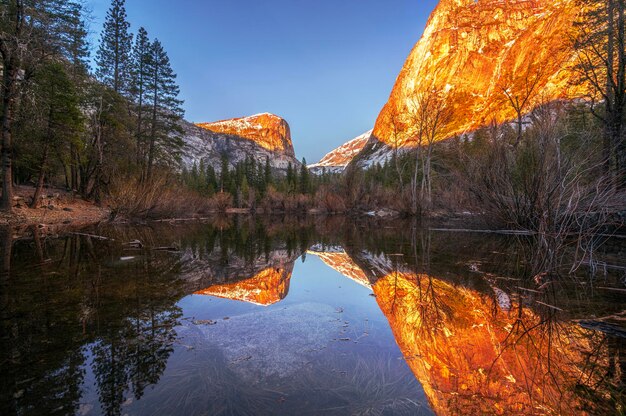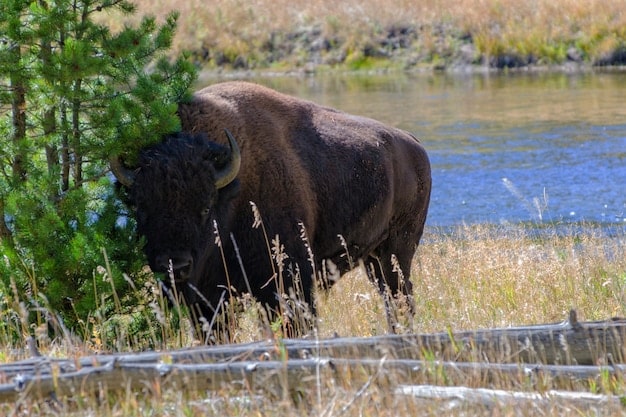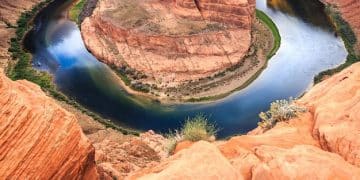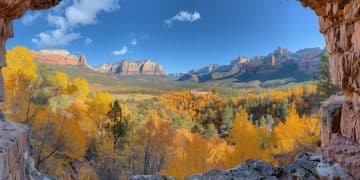How to Photograph US National Parks: Capture Stunning Landscapes

How to photograph US National Parks involves understanding the unique landscapes and wildlife, mastering your camera settings, and planning your visits during optimal lighting conditions to create stunning, memorable images.
Imagine capturing the majestic beauty of the Grand Canyon at sunrise or the playful antics of bison in Yellowstone. How to photograph US National Parks: A Guide to Capturing Stunning Landscapes and Wildlife will help you turn these dreams into reality, offering expert tips and techniques to elevate your photography game in America’s most breathtaking natural settings.
Planning Your Trip: Essential Preparation for National Park Photography
Before even thinking about camera settings or lenses, meticulous planning is paramount. This includes researching the best times to visit specific parks, understanding seasonal changes, and obtaining the necessary permits. Adequate preparation dramatically increases your chances of capturing exceptional photographs.
Researching National Park Locations
Each national park boasts its own unique charm and photo opportunities. Delve into the specifics of your chosen park to identify key viewpoints and understand how light interacts with the landscape at different times of the year.
Timing is Everything: Seasonal Considerations
Seasons significantly impact the visual appeal of national parks. Autumn foliage in Acadia, snow-capped peaks in Glacier, or wildflowers in the Great Smoky Mountains each present unique photographic possibilities. Plan your trip accordingly.
- Check weather forecasts regularly: Conditions can change rapidly, especially in mountain regions.
- Obtain necessary permits: Some parks require permits for specific areas or activities, including photography.
- Research optimal lighting conditions: Dawn and dusk, often referred to as the “golden hours,” usually provide the most dramatic light.
- Understand wildlife behaviors: Knowing when and where animals are most active can lead to remarkable wildlife encounters.
Thorough research and planning pave the way for a successful and photographically rewarding trip to any US National Park. By anticipating challenges and understanding the best times and locations for photography, you’ll be well-equipped to capture the park’s unique beauty.
Gears and Equipment: Choosing the Right Tools for the Job
Selecting the right photography gear for national park environments is crucial. While a high-end camera is beneficial, understanding how to utilize your equipment effectively is even more important. From lenses to tripods, each tool plays a role in capturing the perfect shot.
Camera Bodies: Sensor Size and Features
The choice of camera body often comes down to personal preference and budget. Full-frame sensors offer superior image quality in low light, while crop-sensor cameras are more compact and affordable.
Lenses: Wide-Angle, Telephoto, and Versatile Zooms
A diverse lens selection is essential for capturing the wide range of subjects found in national parks. Wide-angle lenses are ideal for grand landscapes, while telephoto lenses bring distant wildlife into sharp focus.

Investing in quality gear and understanding how to use it effectively will significantly enhance your ability to capture stunning images in the diverse environments of US National Parks. Don’t underestimate the importance of practice and experimentation – the more comfortable you are with your equipment, the better your photographs will be.
Mastering Camera Settings: Essential Techniques for Landscape Photography
National park photography demands a strong understanding of camera settings. Mastering aperture, shutter speed, ISO, and white balance allows you to adapt to varying lighting conditions and creative visions.
Aperture: Depth of Field and Sharpness
Aperture controls the amount of light entering the camera and influences depth of field – the area of the image that appears sharp. For landscapes, a smaller aperture (f/8 to f/16) generally provides greater depth of field, ensuring that both foreground and background are in focus.
Shutter Speed: Capturing Motion and Light
Shutter speed determines how long the camera’s sensor is exposed to light. Fast shutter speeds freeze motion, ideal for wildlife photography, while slow shutter speeds create motion blur, often used to smooth water in landscapes.
- Use a tripod: A tripod is essential for sharp landscape photographs, especially in low light or when using slow shutter speeds.
- Shoot in RAW format: RAW files capture more data than JPEGs, providing greater flexibility for editing.
- Understand the histogram: The histogram displays the tonal range of your image, helping you avoid overexposure or underexposure.
Experimenting with different camera settings is key to developing your personal style and capturing unique perspectives. Don’t be afraid to push the boundaries and try new techniques to unlock the full potential of your national park photography.
Composition Techniques: Creating Visually Compelling Images
Even with the best gear and settings, a poorly composed image can fall flat. Understanding composition techniques like the rule of thirds, leading lines, and framing can transform ordinary scenes into visually captivating photographs.
The Rule of Thirds: Creating Balance and Interest
The rule of thirds involves dividing your frame into nine equal parts using two horizontal and two vertical lines. Placing key elements along these lines or at their intersections creates a more balanced and visually appealing composition.
Leading Lines: Guiding the Eye Through the Frame
Leading lines draw the viewer’s eye through the image, creating a sense of depth and leading them towards the main subject. Roads, rivers, and even rock formations can serve as effective leading lines.

By incorporating these composition techniques into your photography, you can elevate your images from simple snapshots to compelling works of art. Remember, practice and experimentation are essential to mastering these skills and developing your own unique photographic style. The more you shoot, the better you’ll become at instinctively recognizing strong compositions.
Wildlife Photography: Ethical Practices and Techniques
Photographing wildlife in national parks requires a delicate balance of capturing stunning images and respecting the animals and their environment. Ethical practices are paramount to ensure minimal disturbance and protect these creatures for future generations.
Maintaining a Safe Distance: Respecting Wildlife Boundaries
Always maintain a safe distance from wildlife, using a telephoto lens to capture detailed images without encroaching on their space. Observe park regulations and guidelines regarding wildlife encounters.
Using Telephoto Lenses: Capturing Details from Afar
Telephoto lenses are essential for wildlife photography, allowing you to capture intimate details without disturbing the animals. Consider lenses with image stabilization to combat camera shake at long focal lengths.
- Avoid feeding animals: Feeding wildlife can disrupt their natural behaviors and make them dependent on humans.
- Be aware of breeding seasons: During breeding seasons, animals are particularly sensitive, so extra caution is required.
- Respect park regulations: National parks have specific rules regarding wildlife interactions, which are designed to protect both animals and visitors.
Practicing ethical wildlife photography not only protects the animals but also enhances the overall experience for everyone. By respecting their space and adhering to park regulations, you can capture incredible images while contributing to the preservation of these magnificent creatures.
Post-Processing: Enhancing Your National Park Photographs
Post-processing is an integral part of the digital photography workflow. Software like Adobe Lightroom and Photoshop allows you to fine-tune your images, adjusting exposure, contrast, and colors to bring out the best in your national park photographs.
Basic Adjustments: Exposure, Contrast, and White Balance
Start with basic adjustments to exposure, contrast, and white balance to correct any imperfections in the original image. Pay attention to detail and make subtle changes to avoid over-processing.
Color Grading: Enhancing Mood and Atmosphere
Color grading involves adjusting the colors in your image to create a specific mood or atmosphere. Experiment with different color profiles and adjustments to find the look that best suits your vision.
However, it’s crucial to maintain a sense of realism and avoid excessive manipulations that distort the true beauty of the scene. The goal is to enhance, not fabricate, the natural wonder you captured in the park.
| Key Point | Brief Description |
|---|---|
| 📸 Planning the Trip | Research locations and optimal times for the best shots. |
| 🏞️ Mastering Settings | Adjust aperture, shutter speed, and ISO for landscape and wildlife. |
| 🦉Ethical Wildlife | Keep a safe distance and respect wildlife boundaries. |
| 💻 Post-Processing | Enhance photos with basic adjustments and color grading. |
Frequently Asked Questions
▼
The “golden hours,” shortly after sunrise and before sunset, offer the most flattering light. The soft, warm light enhances colors and creates dramatic shadows, perfect for landscape photography.
▼
A versatile lens, tripod, and extra batteries are crucial. A wide-angle lens captures landscapes, while a telephoto lens is ideal for wildlife. A sturdy tripod ensures sharp images.
▼
Employ the rule of thirds, leading lines, and framing techniques. Placing key elements along the lines or at their intersections creates a balanced and visually appealing composition.
▼
Maintain a safe distance, avoid feeding animals, and respect park regulations. Use a telephoto lens to capture details from afar and minimize disturbance to the animals.
▼
Aim for natural enhancements. Adjust exposure, contrast, and colors subtly to bring out the best in the image without creating artificial results. Maintain a sense of realism.
Conclusion
Mastering the art of photographing US National Parks involves a blend of preparation, technical skill, and creative vision. By understanding your gear, respecting the environment, and applying composition techniques, you can capture images that showcase the breathtaking beauty of these natural wonders. Embrace the challenge, experiment with different approaches, and let your passion for photography guide you to create stunning visuals that inspire others to appreciate and protect these invaluable treasures.





